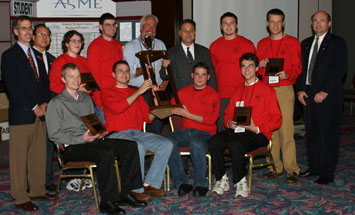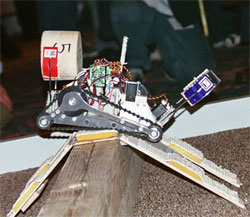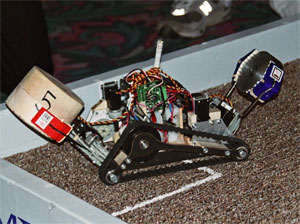Fieldcrest graduate Jerrod Hock was a member of the Southern Illinois University-Edwardsville design team that won the international competition
for the National ASME Student Design Contest.
The regional student teams were given the task of designing, building and demonstrating a vehicle that will navigate over or around
several obstacles and retrieve six simulated mines from a minefield and place them into a controlled receiving area within a three-minute time frame.
Each simulated mine was given a weighted value depending on the difficulty of retrieval.
The team with the highest value of mines retrieved was the winner.
Jerrod, son of Mr. and Mrs. Richard Hock, Jr., was one of the main designers of the
tracked vehicle and designed the track assemblies and undercarriage for the rover. He also
fabricated, machined all steel and aluminum parts and modified other purchased components.
The names and duties of the
4 man team seated in the picture below are as follows:
From left to right. Dennis O'connor (in the grey shirt) was the driver of the rover and
also designed and fabricated the wooden bridges used to overcome obstacles. Andrew Rummer
aided in fund raising and did the graphic design for the team shirts. Jerrod Hock designed
the vehicle and manufactured all of the components. Chad Burns, on the far right, designed
the jaws and their components, and programmed the remote control.

Technology is playing a key role in assisting trained professionals world wide with the
daunting task of locating undetected anti-personnel landmines, remnants of past wars and
conflicts. According to the United Nations Association of the USA, 50 million landmines are
buried and active in nearly 70 countries throughout the world. These mines injure or kill
thousands of innocent men, women, and children every year.
In an effort to prevent future injury to citizens worldwide, ASME student members were
asked to contribute to this noble cause by participating in the 2004 Student Design Contest.
The contest was dubbed "Mine Madness," and was presented by the ASME and sponsored by The Boeing Company.
Some of the design requirements for the remote controlled rover were:
12 volt power limit using C batteries, no 12 or 6 volt batteries are allowed,
must fit in a 30x30x30 centimeter cube,
no aviation frequency controllers were allowed,
one minute of set-up and reset time was allowed.

Remote rover that won design contest.


